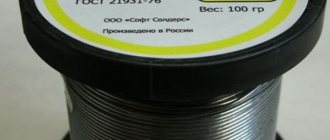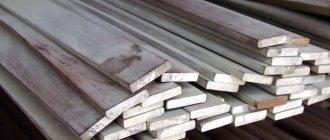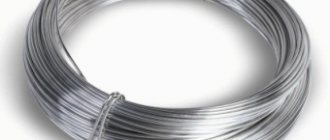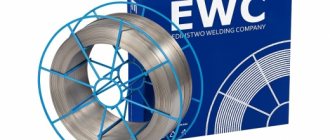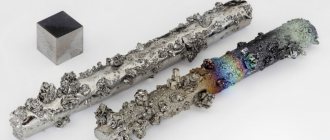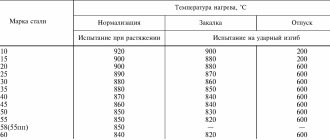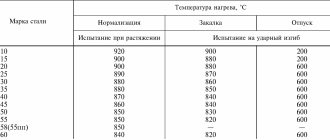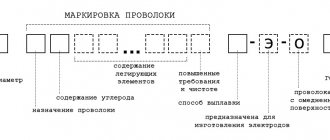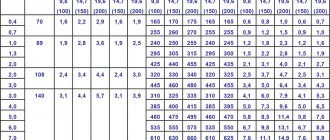Spring wire GOST 9389-75 is a cold-drawn carbon steel wire used for the manufacture of cold-wound springs that are not subject to hardening.
A spring is an elastic element used to absorb shocks and shocks, vibration isolation, create specified initial forces, and accumulate mechanical energy.
Spring wire GOST 9389-75 is manufactured:
- by mechanical properties: grades A, B, C;
- classes 1, 2, 2A, 3.
- normal accuracy;
Spring wire of classes 1, 2, 3 is manufactured with normal and increased accuracy, class 2A - with increased accuracy.
Types and method of manufacture
In industry and in everyday life, various types of metal have become the most in demand. After heat treatment they acquire powerful spring properties. Such alloys include:
At factories, wire GOST 9389–75 is produced in two types of accuracy:
The cross-section of the spring wire GOST 9389 75 should not exceed the range of 0.2−30 mm. Typically the product has a round cross-section. Sometimes special-purpose parts may have a different geometric appearance:
To manufacture this fastener, the drawing method is used. The workpiece is pulled through holes of different diameters. The diameter of the hole gradually decreases. At the finishing stage there is a calibration die. This technology makes it possible to obtain high accuracy and the size of a given section. The result is a smooth surface without burrs.
Then the product undergoes heat treatment. As a result, spring properties are improved and the tensile strength coefficient increases.
The finished product in the coil is coated with a thick layer of preservative lubricant. It protects the wire from rust and corrosion. The bay is wrapped in moisture-proof paper. The finished coil is additionally covered with plastic film.
Tags
STEEL WIREspring wire in Wire classes Diameter of wire and diameter of SPRING wire application of spring wireGOST spring wireGOST spring wire GOST 9389spring GOST 9389wire GOST 9389according to GOST 6507 and GOST 4381vM GOST 1763.
steelsstrength carbon application cold drawn deviations pipes dimensions used run-up reference sheets home nmm tape materials data used alloy produced limiting types of bronze square corrosion share company galvanized industry diameter regulatory documentation working tension such
Characteristics of spring material
Wire GOST 9389–75 has its own technological features. High precision products are designated 2A. The remaining groups have lower rates. The main parameters that you need to pay attention to are:
- Cross section - 0.14−8 mm.
- The permissible error in diameter is no more than 0.05 mm.
- Each class has a different breaking resistance coefficient. It is subject to regulatory requirements. Its value should be in the range 1030−3090 N/mm2.
- The number of twists depends on the material of manufacture. Typically this number does not exceed 4−35 times.
- The weight of the product depends on its diameter. The calculation is carried out for 1000 meters.
Finished products can be subjected to several technological operations according to individual customer requirements:
Application areas of fasteners
Steel spring wire has become widespread in several industries in the creation of various metal structures.
A large amount of this material is used in the manufacture of springs. Moreover, these products belong to heavily loaded devices. This type of spring is subjected to special tests regarding its wear resistance. After winding, all springs must be hardened. To create a rigid structure, the product was also used in the furniture industry. Finished products are shipped in special coils or coils. Excellent packaging saves the product from corrosion.
Spring wire is constantly used during general construction work as the main material from which the spring is made.
Unlike ordinary wire, spring wire has memory. This property is widely used to create beautiful jewelry.
The composition of this product includes an alloy of neodymium and titanium. The cost of this material is very high. However, this combination gives the product unique properties.
You can purchase such steel wire with memory in a store that sells goods for folk art. It will be possible to make bracelets from it that can retain their shape.
The originality of memory wire is that if it is straightened and then heated after a few hours, it will return to its original appearance. To remember, the product should be given the desired shape - let it lie and then straighten it. After heating, the wire will take its previous appearance.
In stores, such products are sold in the form of beautiful rings. It is in this form that they retain their shape. Rings are available in different diameters.
Various types of springs used in the automotive industry are made from such wire. In almost every modern car you can find a large number of springs of different diameters that perform important work.
Recommendations for the use of spring wire depending on brands and classes
- The relative strength run-up is calculated using the formula:
- K = Δσв / σв
- Where:
- Δσв — run-up of temporary tensile strength in a batch, N/mm2;
- σв is the minimum value of tensile strength in the class, N/mm2.
Diameter and maximum deviations along it of spring wire
1. At the request of the consumer, the supply of wire of intermediate diameters is allowed. In this case, the maximum deviations in diameter must correspond to those established for the nearest larger diameter.
2. The ovality of the wire should not exceed half of the diameter tolerance range.
- Examples of symbols:
- Spring wire, grade A, class 1, increased precision, diameter 1.20 mm:
- Wire A-1-P-1.2 GOST 9389-75
- Spring wire grade B, class 3, normal accuracy, diameter 2.0 mm:
- Wire B-3-2 GOST 9389-75
- Spring wire grade B, class 2A, increased precision, diameter 1.20 mm:
- Wire B-2A-1.2 GOST 9389-75
Steel carbon spring wire GOST 9389 is manufactured in accordance with the requirements of the standard according to technological regulations approved in the prescribed manner, from carbon steel in accordance with GOST 1050-88, GOST 14959-79, GOST 1435-90 or according to normative and technical documentation, as well as from steels grades KT-2 and ZK-7, the chemical composition of which is indicated in Table 2, and other special steels manufactured according to regulatory and technical documentation. In this case, class 2A wire must be made of steel with a mass fraction of sulfur not exceeding 0.030% and phosphorus not exceeding 0.035%.
Hot rolled steel for springs
according to GOST 7419-90
The standard applies to hot-rolled strip, trapezoidal-step, T-shaped, trapezoidal and grooved rolled products for springs
Rolled products are divided according to accuracy: A - high; B - increased; B - ordinary. Rolled products are manufactured in lengths from 2 to 6 m. At the consumer's request, rolled products are manufactured in lengths over 6 m. Rolled products are manufactured: in measured length; multiple measured length; measured length with unmeasured segments of at least 1.5 m in length, weighing no more than 10% of the batch weight; of unmeasured length. The rental must be trimmed. The bevel of the cut should not exceed 5% of the width for rolled products up to 80 mm wide and 3% of the width for rolled products over 80 mm wide. Twisting of rolled products around the longitudinal axis is not allowed
Spring wire GOST (9389-75)
The requirements for the functional qualities of steel spring wire are determined by the GOST 9389-75 .
As for dividing the product into conditional categories, spring wire is classified according to manufacturing accuracy, grades and classes of mechanical strength, as well as in accordance with the grade of steel used to produce the product. Depending on the manufacturing precision, steel spring wire can be:
- Normal accuracy.
- Increased accuracy (symbol P). This variety is used in the production process of the most critical components of certain devices.
In accordance with the indicators of mechanical strength, carbon steel spring wire is divided into grades (A, B, C), as well as classes (1, 2, 2A and 3).
The diameter of the finished product can range from 0.2 to 8 millimeters. Its final cost depends on this indicator, as well as on the accuracy of manufacturing the spring wire.
Thus, a wire with a smaller diameter will cost more than a thicker analogue.
After manufacturing, the product is in most cases treated with a special preservative oil that protects the wire from the negative effects of corrosion. The coils and skeins in which the finished product is supplied are packaged with polymer film and moisture-proof paper. The surface of the spring wire should not have nicks, cracks, dulls or rust.
technological features of carbon steel spring wire, areas of application
When a part needs to be given elasticity, as well as special spring properties, GOST 9389–75 “Spring carbon steel wire” is used for its manufacture. Such a detail can have a variety of types. Sometimes it is a strong spring, in other cases it is a pin or hook. The most important quality of spring wire is considered to be high strength. It is able to withstand a large number of compressions without destruction due to metal fatigue.
Types and method of manufacture
In industry and in everyday life, various types of metal have become the most in demand. After heat treatment they acquire powerful spring properties. Such alloys include:
At factories, wire GOST 9389–75 is produced in two types of accuracy:
The cross-section of the spring wire GOST 9389 75 should not exceed the range of 0.2−30 mm. Typically the product has a round cross-section. Sometimes special-purpose parts may have a different geometric appearance:
To manufacture this fastener, the drawing method is used. The workpiece is pulled through holes of different diameters. The diameter of the hole gradually decreases. At the finishing stage there is a calibration die. This technology makes it possible to obtain high accuracy and the size of a given section. The result is a smooth surface without burrs.
Then the product undergoes heat treatment. As a result, spring properties are improved and the tensile strength coefficient increases.
The finished product in the coil is coated with a thick layer of preservative lubricant. It protects the wire from rust and corrosion. The bay is wrapped in moisture-proof paper. The finished coil is additionally covered with plastic film.
Characteristics of spring material
Wire GOST 9389–75 has its own technological features. High precision products are designated 2A. The remaining groups have lower rates. The main parameters that you need to pay attention to are:
- Cross section - 0.14−8 mm.
- The permissible error in diameter is no more than 0.05 mm.
- Each class has a different breaking resistance coefficient. It is subject to regulatory requirements. Its value should be in the range 1030−3090 N/mm2.
- The number of twists depends on the material of manufacture. Typically this number does not exceed 4−35 times.
- The weight of the product depends on its diameter. The calculation is carried out for 1000 meters.
Finished products can be subjected to several technological operations according to individual customer requirements:
Application areas of fasteners
Steel spring wire has become widespread in several industries in the creation of various metal structures. A large amount of this material is used in the manufacture of springs. Moreover, these products belong to heavily loaded devices. This type of spring is subjected to special tests regarding its wear resistance. After winding, all springs must be hardened. To create a rigid structure, the product was also used in the furniture industry.
Finished products are shipped in special coils or coils. Excellent packaging saves the product from corrosion.
GOST 9389-75 Carbon steel spring wire. Specifications (with Amendments No. 1-5)
CARBON STEEL SPRING WIRE
Carbon steel spring wire. Specifications
MKS 77.140.65 OKP 12 2100
Date of introduction 1977-01-01
1. DEVELOPED AND INTRODUCED by the USSR Ministry of Ferrous Metallurgy
2. APPROVED AND ENTERED INTO EFFECT by Resolution of the State Committee of Standards of the Council of Ministers of the USSR dated July 17, 1975 N 1830 Change No. 5 was adopted by the Interstate Council for Standardization, Metrology and Certification (Minutes No. 20 dated November 1, 2001) Voted for adoption:
Name of the national standardization body
State Standard of the Republic of Belarus
Gosstandart of the Republic of Kazakhstan
3. INSTEAD GOST 9389-60
4. REFERENCE REGULATIVE AND TECHNICAL DOCUMENTS
5. The validity period was lifted according to Protocol No. 2-92 of the Interstate Council for Standardization, Metrology and Certification (IUS 2-93)
6. EDITION with Amendments No. 1, 2, 3, 4, 5, approved in February 1983, December 1984, December 1987, January 1990, March 2002 (IUS 5-83, 3- 85, 3-88, 4-90, 6-2002) Amendments were made, published in IUS N 7 2003, IUS N 6 2007
Amendments made by the database manufacturer
This standard applies to cold-drawn carbon steel wire used for the manufacture of springs that are cold-wound and not subject to hardening. (Modified edition, Amendment No. 3).
TYPES AND MAIN SIZES
1.1. The wire is produced:
a) by mechanical properties: grades A, B, B; classes 1, 2, 2A, 3. Recommendations for the use of spring wire depending on the grades and classes are given in Appendix 3.
b) in terms of manufacturing accuracy: normal accuracy; increased accuracy - P. Wire of classes 1, 2, 3 is manufactured with normal and increased accuracy, class 2A - increased accuracy. (Changed edition, Amendment No. 3, 4).
1.2. The wire diameter and maximum deviations along it must correspond to those indicated in Table 1.
Nominal wire diameter
Maximum deviation for wire diameter
Notes:1. At the customer's request, it is possible to supply wire of intermediate diameters. In this case, the maximum deviations in diameter must correspond to those established for the nearest larger diameter.2. The theoretical mass of the wire is given in the appendix.
(Changed edition, Amendment No. 3, 4).
1.3. The ovality of the wire should not exceed half the diameter tolerance range.
Examples of symbols:
Wire grade A, class 1, increased precision, diameter 1.20 mm:
Wire A-1-P-1.2 GOST 9389-75
The same, brand B, class 3, normal accuracy, diameter 2.0 mm:
Wire B-3-2 GOST 9389-75
The same, brand B, class 2A, increased accuracy, diameter 1.20 mm:
Wire B-2A-1.2 GOST 9389-75
(Changed edition, Amendment No. 3, 4).
TECHNICAL REQUIREMENTS
2.1. Steel carbon spring wire must be manufactured in accordance with the requirements of this standard according to technological regulations approved in the prescribed manner, from carbon steel in accordance with GOST 1050, GOST 14959, GOST 1435 or according to regulatory and technical documentation, as well as from steel grades KT-2 and 3K -7, the chemical composition of which is indicated in Table 2, and other special smelting steels manufactured according to regulatory and technical documentation. In this case, class 2A wire must be made of steel with a mass fraction of sulfur not exceeding 0.030% and phosphorus not exceeding 0.035%.
At the request of the consumer, the wire is made from a certain grade of steel. (Changed edition, Amendment No. 2, 3).
2.2. On the surface of the wire there should be no cracks, films, sunsets, hairlines, shells and rust. Risks with a depth of no more than half the tolerance field in diameter are allowed, as well as remnants of technological coatings applied to the surface of the wire to prepare the metal for drawing. Class 2A wire for aviation industry must be without traces of technological copper plating of the surface. (Changed edition, Amendment No. 3).
2.3. The mechanical properties of the wire must comply with the standards specified in Table 3.
Wire diameter, mm
Tensile strength, N/mm (kgf/mm)
Dispersion of temporary tensile strength in a batch, no more, N/mm (kgf/mm)
Number of twists, not less
APPENDIX 1 (for reference). Theoretical weight of 1000 m wire
APPENDIX 1 Reference
| Wire diameter, mm | Cross-sectional area, mm | Weight 1000 m, kg |
| 0,14 | 0,0154 | 0,1208 |
| 0,15 | 0,0177 | 0,1387 |
| 0,16 | 0,0201 | 0,1578 |
| 0,18 | 0,0254 | 0,1994 |
| 0,20 | 0,0314 | 0,2465 |
| 0,22 | 0,0380 | 0,298 |
| 0,25 | 0,0491 | 0,385 |
| 0,28 | 0,0616 | 0,484 |
| 0,30 | 0,0707 | 0,555 |
| 0,32 | 0,0804 | 0,631 |
| 0,36 | 0,1018 | 0,80 |
| 0,40 | 0,1257 | 0,99 |
| 0,45 | 0,159 | 1,25 |
| 0,50 | 0,196 | 1,54 |
| 0,56 | 0,246 | 1,93 |
| 0,60 | 0,283 | 2,22 |
| 0,63 | 0,312 | 2,45 |
| 0,70 | 0,385 | 3,02 |
| 0,75 | 0,442 | 3,47 |
| 0,80 | 0,503 | 3,95 |
| 0,85 | 0,567 | 4,45 |
| 0,90 | 0,636 | 4,99 |
| 1,00 | 0,785 | 6,17 |
| 1,10 | 0,950 | 7,46 |
| 1,20 | 1,131 | 8,88 |
| 1,30 | 1,327 | 10,42 |
| 1,40 | 1,539 | 12,08 |
| 1,50 | 1,767 | 13,87 |
| 1,60 | 2,01 | 15,78 |
| 1,70 | 2,27 | 17,82 |
| 1,80 | 2,54 | 19,94 |
| 1,90 | 2,84 | 22,26 |
| 2,00 | 3,14 | 24,65 |
| 2,10 | 3,46 | 27,19 |
| 2,20 | 3,80 | 29,83 |
| 2,30 | 4,15 | 32,58 |
| 2,50 | 4,91 | 38,54 |
| 2,80 | 6,16 | 48,36 |
| 3,00 | 7,07 | 55,50 |
| 3,20 | 8,04 | 63,11 |
| 3,40 | 9,08 | 71,28 |
| 3,50 | 9,62 | 75,52 |
| 3,60 | 10,18 | 79,9 |
| 4,00 | 12,57 | 98,7 |
| 4,20 | 13,85 | 108,7 |
| 4,50 | 15,90 | 124,8 |
| 5,00 | 19,63 | 154,2 |
| 5,60 | 24,63 | 193,3 |
| 6,00 | 28,3 | 221,9 |
| 6,30 | 31,7 | 244,4 |
| 6,50 | 33,2 | 260,5 |
| 6,70 | 35,3 | 276,8 |
| 7,00 | 38,5 | 302,1 |
| 7,50 | 44,2 | 346,8 |
| 8,00 | 50,3 | 394,6 |
Metaltorg LLC :: Spring wire in Yekaterinburg|metalltorg.su
Good afternoon We offer for delivery from a warehouse in Yekaterinburg wholesale and retail spring wire GOST 9389-75 (patented), (piano), (OVS-especially high resistance, VS-high resistance) steel grades 60,65,70,75,80 ,U8GA,U9A, 1 class, 2 class, 2A class diameters: 0.2 mm; 0.3mm; 0.4mm; 0.5mm; 0.6mm; 0.7mm; 0.8mm; 0.9mm; 1mm; 1.1mm; 1.2mm; 1.4mm; 1.5mm; 1.6mm; 1.8mm; 1.9mm; 2mm; 2.2mm;2.5mm; 3mm; 3.2mm; 3.5mm; 4mm; 4.5mm; 5mm, 6mm; 7mm; 8mm. The wire is used for the manufacture of springs, wound in a cold state and not subjected to hardening, and also, as a wire with elastic and rigid properties, it is used: for pulling cables in pipes, hanging cables, cleaning sewers, for making spring blocks of mattresses, traps, plumbing cables, in modeling, as well as in the production of various household and useful products. The wire is supplied with or without lubricant, in coils: d.0.2mm-0.8mm in coils from 18kg-80kg, d.1mm-4mm from 90-250kg, d.5-8mm from 300kg-1.5t. MetalTorg LLC offers for supply #piano spring wire# GOST 9389-75 wholesale and retail in coils from 1 kg. One of the most frequently asked questions is what grade of wire should I choose?
Wire class 1 according to GOST 9389. High tensile strength. The presence of large residual stresses of the first kind (from drawing and winding) causes the appearance of residual deformations of springs at stresses t 3 > 0.32 Rm. When v max > v k the residual deformations are high, regardless of the application of the captive operation.
Wire of classes 2 and 2A according to GOST 9389. Differs from wire of class 1 in reduced tensile strength and increased ductility. It is used for products operating at low temperatures, as well as for tension springs with complex hook designs. Wire of class 2A differs from wire of class 2 in higher dimensional accuracy, reduction of harmful impurities in the metal and further increase in ductility.
We offer fast delivery of any volume of spring wire to any region of Russia and the CIS along the most optimal route according to the scheme: min. Price - min. Term, with shipment on the day of payment. We will be glad to see you among our beloved clients. Our advantages: any wire GOST 9389-75 in our company is subject to unwinding with subsequent weight control, diameter checking, packaging. We sell any volumes of carbon spring wire, you do not have to buy multi-kilometer skeins if you need, for example, to purchase 10 meters of wire. The goods you paid for are shipped through transport companies of your choice; we provide free delivery to the terminals of transport companies in our city. The most frequently asked question is whether it is necessary to heat treat a spring made from GOST 9389-75 wire? Attention! For information on heat treatment of wire GOST 9389-75 in the manufacture of springs, see below!
Steel table for metal cutting tools
| Tool | steel grade | Quenching temperature °C | Cooling medium | Temperature °C | Note |
| Countersinks | U12A | 760—790 | Water | 210 | Release the shank to 260 °C |
| Sweeps | 212A | 760—790 | “” | 220 | — |
| Pliers, pliers, round nose pliers | U7A | 780—830 | “” | 300 | Heat only the working part |
| Wire cutters | U7A | 780—830 | “” | 240 | — |
| Hammers | U7A | 780—830 | Water | 250 | — |
| Planing irons | U8A | 780—830 | “” | 280 | — |
| Chisels | U8A | 780—830 | “” | 240 | — |
| Carpentry chisels | U8A | 780—830 | “” | 280 | — |
| Machine screwdrivers | U7A | 780—830 | “” | 220 | — |
| Different cutters | RF-1, R8 | 1280 | Oil | 560 (twice) | Slow heating up to 800 °C |
| Manual crimping | U7A, U8A | 780—830 | Water | 280—300 | — |
| Stretches | U8A | 780—830 | “” | 280—300 | — |
| Collets | U8A | 780—830 | “” | 240 | Release the spring part to 200°C |
| Metal scissors | U7A | 780—830 | “” | 240 | — |
| Chisels and crossmessels | U8A, U7A | 810—820 | “” | 240 | — |
| Scribblers | U10A | 760—810 | “” | 200 | — |
| Beards | U7A, U8A | 780-830 | “” | 260 | — |
| scrapers | U12, HG | 830 | Oil | 200 | — |
The tables also show the state of supply of metals, the range of which is very extensive and summarized in special reference books, which should be used.
Alloys in which the main components are iron and carbon are called ferrous metals. Steels in which other elements are added are called alloyed and are divided into tool or special.
In addition to sheet and rod materials, wire and tubes of various diameters and sections are widely used in modeling.
Wire is used to make cords, wing fastenings, rods, landing gear, springs, propeller shafts and many other parts. One of the best and most convenient is piano (aviation) wire of class I (OVS - especially high resistance) and class II (VS - high resistance). The mechanical properties of this wire depend on its diameter. Wire of these classes is produced with a diameter of up to 5 mm and in most cases (except for springs) does not require additional heat treatment.
